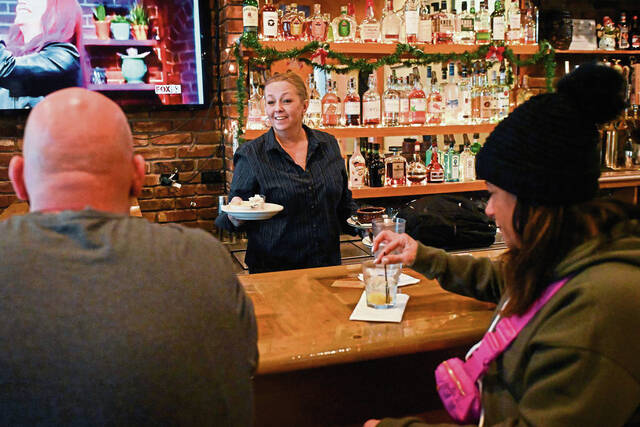Short stack, short staff: Restaurant industry still hurting for workers
For Tracy Allison, a bartender who serves the dining room at Ligonier Tavern and Table while completing a host of other tasks, finding good employees has been an ongoing challenge.
“I have no earthly idea why” it has been so hard to attract and retain workers, said Allison, a Ligonier resident who has been in the hospitality field for some 30 years in Florida, Pittsburgh and now Ligonier.
“You’re stuck with who you got. You don’t dare fire someone,” Allison said, noting “jobs are a dime a dozen.”
What’s left for many in the food service business are the “long haulers” like herself, or new employees, many of whom don’t last long, Allison said Thursday after a busy lunch hour.
The challenges for Ligonier Tavern and Table and countless other establishments competing for workers is nothing new to the industry. They existed before the pandemic slammed the restaurant business, when eateries were prohibited from offering indoor dining in the spring of 2020.
“In 2019, the biggest issue for employers was labor,” said Benjamin Fileccia, senior vice president of strategy and engagement for the Pennsylvania Restaurant & Lodging Association, a Harrisburg-based trade group.
The state-ordered shutdown of indoor dining in 2020 resulted in layoffs that forced workers to find employment elsewhere, if they could. The hospitality industry lost 25% of its workforce, Fileccia said.
“It was always on top of the mind — how to retain and recruit (workers) — and the pandemic exacerbated that,” said Stephanie Otterson, spokeswoman for the Pennsylvania Restaurant & Lodging Association.
Related:
• Pittsburgh unemployment near record lows, but region is slow to regain workers
The restaurants find themselves in a bind, however, because, as worker shortages continue, restaurants are picking up more foot traffic, said Gregory Gamble, an account representative at PA CareerLink, a state office near Youngwood that provides employment information.
“Overall, restaurants everywhere are hurting for people,” Gamble said.
It’s not like there is a lack of unemployed workers in Westmoreland County. There were 5,800 individuals seeking jobs as of October, which was 3,100 fewer jobless than a year ago, according to the latest data from the state’s Center for Workforce Information and Analysis.
Since October 2020, food service businesses, taverns and bars in the seven-county Pittsburgh region added 16,300 jobs, increasing staff numbers to 86,200 this October, according to the center.
Meanwhile, across the nation, there are about 1.4 million vacancies in the hospitality industry, Fileccia said.
But Gamble and Fileccia see a glimmer of hope for the future.
Fileccia is seeing fewer “pain points” from trade association members complaining about the lack of workers.
“I always get (complaints), but not in the volume I was getting nine months ago,” he said.
Part of the reason may be that restaurants have responded to the competition for the same workers by raising wages for the “back of the house” employees, such as kitchen staff, Fileccia said. And servers are receiving higher tips as menu prices have increased.
“The wages are above $15 an hour,” he said.
Remove the ads from your TribLIVE reading experience but still support the journalists who create the content with TribLIVE Ad-Free.

